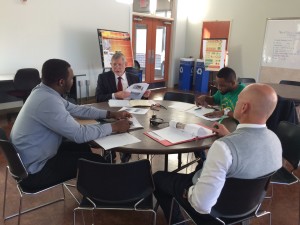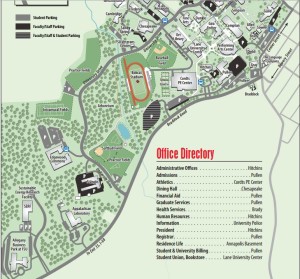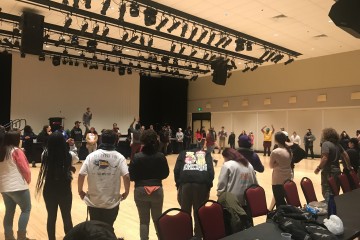SERF Still Unfinished Five Years after Proposed Completion Date
Although Frostburg State University’s Sustainable Energy Research Facility (SERF) was initially scheduled to be completed in 2010 and had its dedication in Fall 2012, the $2,787,183 building is still incomplete.
Nearing the end of its grant funding, SERF is on its third project manager and currently lacks a director, as well as a clear timeline for hiring a new one. SERF was also the subject of a damning state audit in 2013.
SERF’s design and construction was supposed to begin in 2009 after Maryland Congressman Roscoe Bartlett secured the initial funding for the building, a grant from the U.S. Department of Energy, according to a 2009 press release from FSU. “The building will be completely functional in fall 2010 and accommodate the FSU Renewable Energy Center to conduct research, education and outreach programs,” the press release said.
However, “actual building construction began in the fall of 2011, despite what the goal was when the grant was first awarded,” according to Liz Medcalf, FSU’s director of news and media services. “Completion was delayed a couple of times along the way.”
According to Aaron Hoel, FSU’s Director for the Office of Research and Sponsored Programs, SERF “is not 100% grant funded. The first grant was awarded for the construction of the building. That grant was for $738,000 but required the University to also spend $738,000 in the construction. This grant ended February 2011. The second grant was awarded to install equipment and staff the facility. That grant was for $856,350 but required that the University spend $454,833. This grant is still active until March 2016.”
At press time, the Department of Energy had not replied to a request for comment.
Getting SERF off the ground and fully operational has been difficult for the design team, according to Dr. Joe Hoffman, who is the dean of the college of liberal arts and sciences. Although SERF had its dedication in 2012, Hoffman says that was “premature,” and that SERF “was never completed in the sense that it was fully functioning and operational.”

“Part of the problem with this kind of research is that it involves a very large team of architects, construction management people, engineers, and all of them are focused on what the building would look like, if it were to function in a sustainable way and be a functioning research lab,” he explained. “It took years for the design team to settle on particular features that are now incorporated in that building.”
Other buildings on campus, like the Gira Center for Communications and Information Technology, had a more clear cut goal using “off-the-shelf technologies” in ways that the engineers and architects understood, Hoffman said.
Dr. Oguz Soysal was the original project manager, but he was replaced by Dr. Muhammed Eltayeb after progress stalled. Eltayeb left the project in spring 2015, and Hoffman is the current project manager. At press time, Soysal and Eltayeb had not responded to a request for comment.
A 2013 audit of SERF conducted by Maryland’s office of legislative audits found many problems with the building’s progress. According to the audit, SERF was designed to be a residential type building or exhibition house of approximately 4,000 square feet, costing $1,476,000. Plans were revised and the building’s size increased to 6,300 square feet, increasing design and construction costs to approximately $2 million, with the additional costs being funded with FSU unrestricted funds, the audit said.
The audit also found that FSU “did not document the rationale for its selection of the construction site, did not obtain the required control agency approvals, and did not ensure construction costs were reasonable.”
SERF was built in the Allegany Business Center, which was leased to Allegany County in 2001. Building SERF in that center required the use of a specific contractor, Academic Privatization, LLC (AP), because of the county’s leasing agreement. AP is a student housing developer based in Georgia. FSU did not request the student housing developer to bid the project – the construction of a research facility – to another contractor, according to the audit.
AP is the same company that built Edgewood Commons, an apartment style housing option for FSU students, in August 2003.
The construction plan was not initially submitted to the Board of Public Works, as is required for projects costing more than $500,000. Projects costing between $1 million and $5 million require approval from the University System of Maryland Chancellor.
The audit recommended that FSU comply with all regulations and refer the case to the State Ethics Commission (SEC).
Michael Lord, the executive director of the SEC, said, “As provided both in the Ethics Law (section 5-407) and regulations, a complaint filed with the Ethics Commission is confidential and remains that way unless it is referred to outside authorities for prosecution or the Ethics Commission finds that a violation has been committed. Absent one of those exceptions, the Commission is not at liberty to discuss a complaint. Furthermore, as a matter of policy the Commission does not acknowledge whether or not it has received a complaint in a particular matter.
“Complaints that have resulted in a finding of violation are the subject of a public order, which are posted on the Commission’s website at http://ethics.maryland.gov/. I can tell you that there is no public order addressing the matter in which you’re interested.”
In response to the audit, FSU officials wrote, “FSU agrees and remains committed to fully complying with all procurement policies set by USM and will continue to be so committed.”
In addition to difficulties with the design and a legislative audit, the facility is without a director. Dr. Steven Tidrow, who served as SERF’s director from March until mid-August, is now a professor at Alfred University.
“Dr. Steve Tidrow was absolutely wonderful, the best possible person we could have hired,” Hoffman said. “Another institution [Alfred University] set their eyes on Dr. Tidrow and they, as they say, ‘made him an offer he couldn’t refuse.’” Hoffman said Tidrow’s new position involves “a substantial salary increase” and the opportunity to direct a research group. “We regretted seeing him leaving,” Hoffman said.
Tidrow did not respond to a request for comment.
Hoffman said he’s hopeful a new SERF director can be hired before the end of the calendar year, when he hopes to have SERF completed.
“As Dr. Hoffman indicated, we would like to have a new director on duty as soon as possible,” said Dr. Ahmad Tootoonchi, FSU’s interim provost. “However, due to complexity of the situation, Dr. Bowling asked for a careful investigation of the situation to see if the facility is actually ready for a new director to step in and move the project forward.”
A university spokesperson said that there is a line in the budget for a SERF director, but did not confirm whether the director would be hired by the end of this calendar year, as hoped.
Currently, SERF is undergoing upgrades, including additional solar voltaic panels to increase electricity, a new battery bank to store the energy, and a complex control system.
“Many of the projects that were done by student groups over the last couple years were focused on the small aspects of that control system,” said Hoffman. “Rather than buying it off the shelf, we basically designed and installed the system ourselves using students to a great extent.”
Two recent graduates of FSU – Mayowa Ogendipe and Raymond Azenedaga – began working on the project during their freshman year. Primarily, they focused on developing the building’s control system, which uses wireless sensors to monitor temperature data throughout the building and modify energy use based on this data. Excess energy is stored in batteries, as the control system will not use unnecessary energy.
Hoffman said that next semester, engineering capstone students will have the opportunity to conduct research in SERF. “It’s been designed so that we can do research on sustainable energy resources that are not for industrial scale use, but for small scale distributing use, like homeowners and small businesses,” he explained.
Some students have had the opportunity to conduct research in SERF. Ogendipe said, “We’ve had a couple students come up here. Last semester, we had a whole class come in to conduct research here.” Students helped with everything from circuit building to data collection.
Hoffman initially told The Bottom Line in an interview that SERF has been completely off the grid since May 2014. “At this point, it’s functioning very nicely,” he said. “It’s off the grid, and it has been since May of last year [2014].” However, Ogendipe later said that SERF went off the grid on March 23, 2015.
“It was March 2015 for final cutting the cord,” Hoffman confirmed. “We had temporary power provided for construction purposes before that.”

The building is powered by solar panels, a wind turbine, a geothermal well, and a biomass burner, which generates energy by burning wood.
“In terms of electrical power, SERF is able to generate around 24kW in certain configuration,” said Ogendipe. “However, with the configuration we run SERF at the moment, we can produce around 18kW. This is because we dedicated one of our inverters strictly for some emergency scenarios. The energy generated varies based on the electric load at serf. For example, when all the batteries are fully charged, the power produced will depend on the equipment being used.”
With the building now nearing completion, Hoffman is ambitious about its potential impact on the region. “This is the kind of magnet that could bring industry here,” Hoffman said on the possibility of sustainable energy companies locating in the area.
“This is really a cool project that I think is going to have a long lasting value not just to FSU, but to the community.”





1 Comment